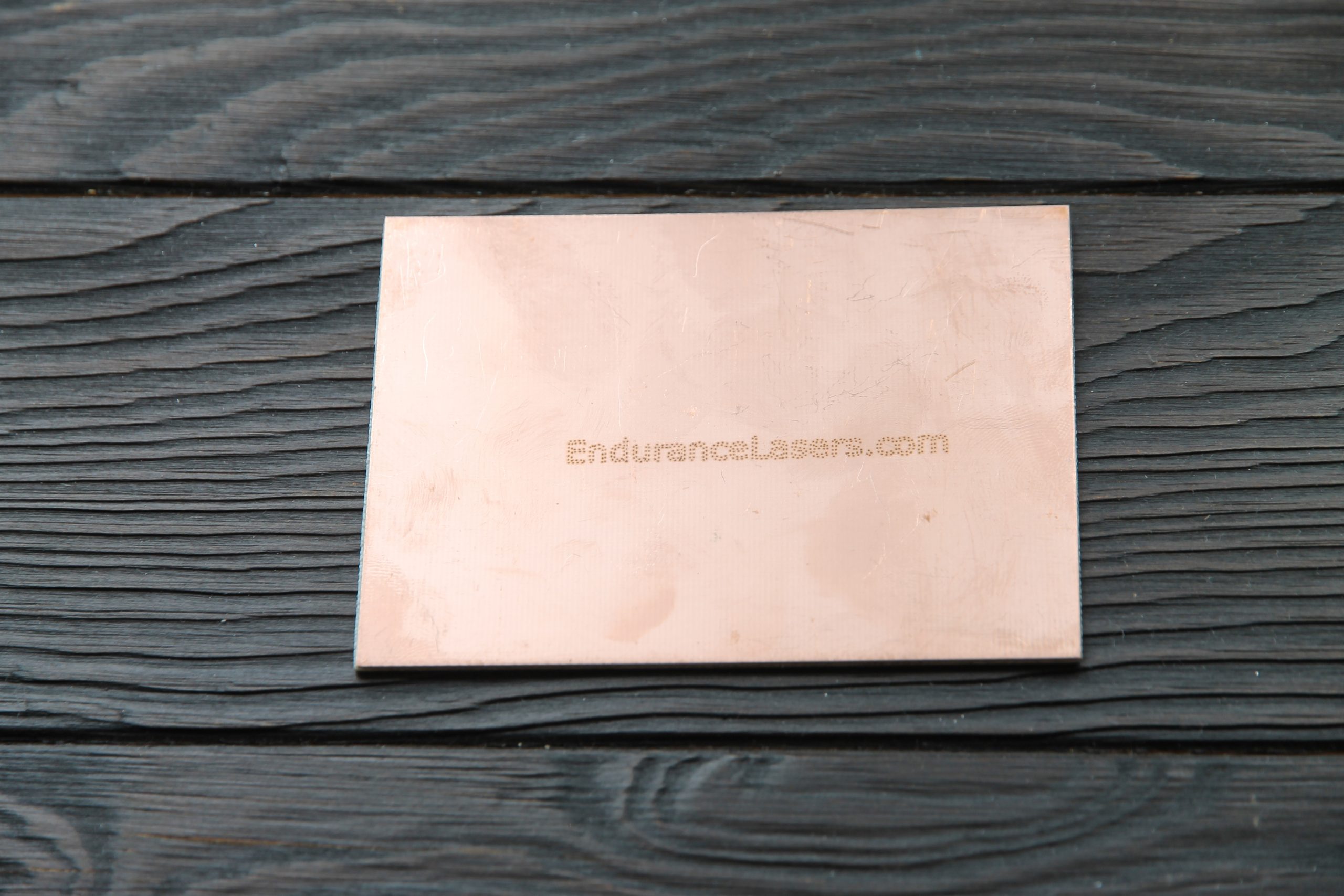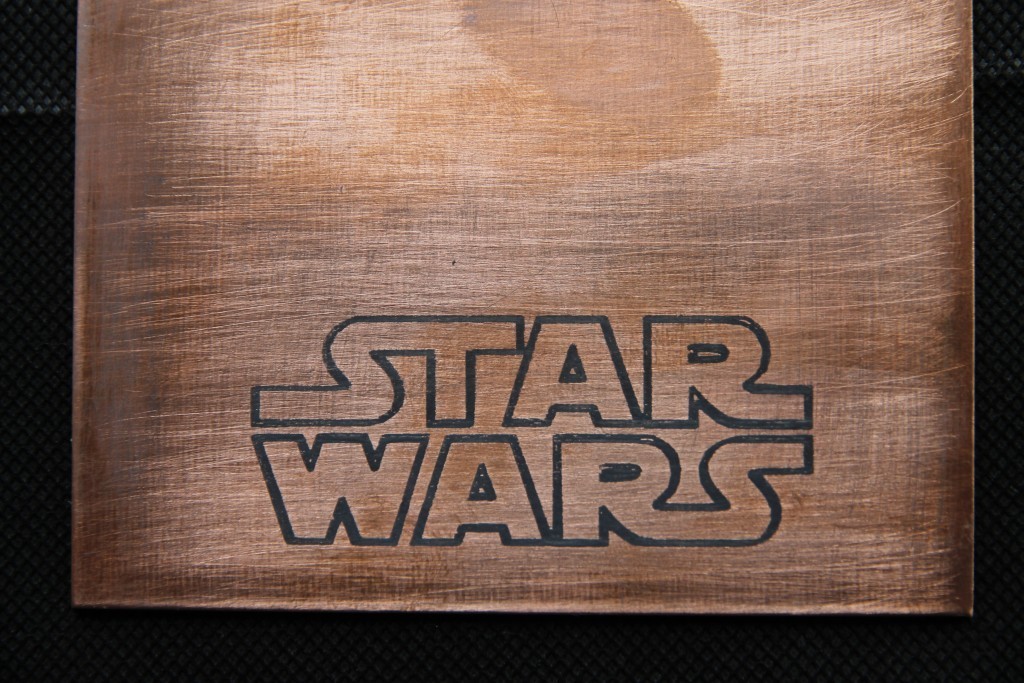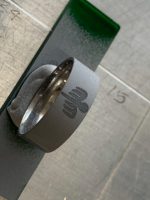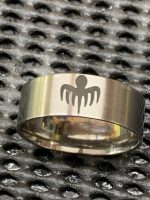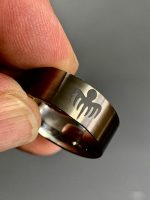The technology of laser etching – all you need to know
20 watt Endurance dual laser is the best instrument for metal etching >>>
One of the most important processes in present-day production is the marking of the output product. Marking of parts, blocks or end products make it possible for the manufacturer to control the turnout and quality of the production and promote their brand. Product labeling gives the end-user information about the type and parameters of the product and quality assurance from the manufacturer. Laser marking is the most advanced of all the existing marking methods today because it allows to control the laser beam and precisely dose the laser energy in time and space. The variety of laser-marked materials is very wide: metals and alloys, ceramics, plastics, semiconductors, glass, wood, etc. Laser marking does not affect the qualities of the marked production and is done in a good manner, free from inaccuracy and at a high rate.
More about laser marking/engraving process
How to make a color metal engraving on stainless steel – all you need to know.
Laser Marking / Engraving Physics
The interaction of the incident laser light with the treated material depends on three components: the measure of the reflected, absorbed and transmitted radiation. The reflected and transmitted radiation does not give away its energy to the material; thus, the marking depends on the quantity of the absorbed energy. The absorption ability depends on the wavelength of the incident laser light, which defines the incident laser light power.
With the decrease of the wavelength the laser energy increases.
E = h * c/λ,
where h is the Planck constant; c is the speed of light in vacuum; λ is a wavelength.
With the wavelength decrease the material reflection power decreases, therefore, a greater quantity of energy will be absorbed by the treated material.
The energy absorbed by the material is spent either on the vibratory or electronic excitation or on the photochemical reaction.
At the vibratory excitation, the absorbed photon energy stimulates molecular vibrations in the material, including stretching, bending or rotating of the atomic bonds. When rotating, molecular vibrations make atoms rub against each other causing temperature increase and vibration transfer to the adjacent atoms.
If the incident photon has sufficiently high energy it can evoke electronic excitation. After absorption the excited electron can spend the received energy on the photon emission or on the vibratory excitation.
The photon emission will not change the material or its properties, but the vibratory excitation as a result of the heat emission can change the material.
The photochemical reaction takes place if the absorbed photon energy causes a chemical reaction. Titanium dioxide (TiO₂) reduction is an example of photochemical absorption. Titanium dioxide (it is white) is usually added to plastics as a pigment:
UV
ηO₂———→Oχ + ηO₂-χ ( χ =0 to 1)¹
The UV- photon is able to destroy chemical bonds and remove part of the oxygen (reduction). The marked area of the plastics blackens – a distinct contrast is made. A photochemical reaction of all processes requires the greatest quantity of photon energy.
Laser Marking / Engraving Types
There are four types of laser effects on the surface of the treated material.
Surface contrast creation is characterized by the high speed of the beam scanning on the surface and/or by short pulses. The color is changed only on the material surface, which absorbs the laser light. This creates a visible contrast with the intact surface of the material. This type of laser effect is known as the photochemical effect. It is often used to mark labels for goods. Special thermal paper, changing the color under the beam influence, is used. Some facsimile equipment works in the same manner.
The advantages of this type of marking are as follows:
* low power necessary for marking,
* equipment compactness,
* ultra-high efficiency (beam scanning speed up to 1500 mm/sec),
* high-resolution capability,
* contactless working.
The drawbacks:
*necessity to use special materials,
*possible deterioration of the marking due to the sunlight or temperature, etc.
Partial melting of the surface is a slower process when the material hits the melting temperature, and through the chemical decomposition, oxidation effects or changes of the surface morphology make for visible marking. It is seldom used for metal surfaces marking due to low contrast. For example, a white marking on dark plastic surfaces appears due to sponging (foaming) of the plastics treated with a laser beam. A laser beam melts plastic, where gas bubbles are created due to carbon combustion with CO2 formation or due to thermal decomposition of the plastic. The gas bubbles go up to the surface but do not leave the material due to the hardening of the melted plastic, and form foam. High-density polyolefins and high-density polyethylene are prone to foaming. The main drawback of this method is low wear resistance of the marking.
Surface engraving or full removal of the material is the slowest marking process since the material is being evaporated. The marking becomes well visible, as the environmental light contradistinguishes the depth of the canal against the non-marked area. This technology is widely spread in all fields of manufacturing. In microelectronics, it is used to mark components, products, and accessories at all stages of development and manufacture, for silicon slabs, for example.
Parameters of the treated material play a significant role in this type of marking. The most important of them are heat conductivity, boiling heat and the coefficient of laser beam reflection. On the assumption that all the removed material is evaporated, the quantity of the material to be removed with a laser depends on the value of the boiling heat. The maximum depth of the evaporated material is defined by the formula:
E₀
D = ———————-
Aρ(c(T₁ – T₀) + L
where, c is the specific thermal capacity; T₁ is the boiling temperature; T₀ is the environmental temperature; L is the boiling heat; A is an exposed area, ρ is the material density; E₀ is the received laser energy. The formula stems directly from the law of conservation of energy. It is worthwhile pointing out that all the energy is divided into the absorbed E₀ and reflected.
The formula gives only an approximate evaluation. It is important to understand that the material thermophysical parameters vary depending on the sample temperature and the beam wavelength. The mode structure (energy distribution inside the laser beam) has the strongest impact on the form of the resulted hole.
The emission power also has a significant influence on the marking process. It is difficult to describe the correlation analytically as at different layers of the energy density the processes run in an individual way. At slow heating with a continuous laser, the most important criteria are the inward heat transmission. In this case, the evaporating point is rather high. For flat samples, a big role plays the depth.
If the energy input is greater than the heat transfer energy the material starts melting.
With the intensity increase (that is, with the change-over to pulse lasers), the secondary surface emissivity and, as a consequence, the energy diversion to the environment starts to have a significant effect. At 105 W/cm2, the process starts showing new properties. This is due to the fact that above the sample surface a plasma cloud, partially screening the surface, is formed. The energy loss, in this case, can reach 40%. To avoid this it is necessary to pause when pulsing. The continued increase of the specific emission energy activates the process of the mechanical as well as a thermal breakdown of the material. In this case, a micro explosion takes place on the surface. Explosions facilitate out squeezing of all the material, which is in the liquid phase, and it’s splattering around, at considerable distances comparable to or even outpassing the working beam diameter. Besides, quick heating stimulates various chemical reactions in the application area. When working without creating a special media, processes of oxidation prevail. This factor plays an important role in marking products since it allows to get chemical entities with the color different from that of the main material. This layer often holdfasts long on the surface and allows attaining patterns of high quality.
Surface engraving with melting is a combination of material removing with melting, which occurs at the bottom of the engraved canal. It is used for engraving of metallic parts.
An optical fiber (OF) lasers open new technological possibilities for materials marking. They have laser beams of a higher quality. OF lasers have high working frequencies, ensuring higher productivity. Thanks to the laser beam stability, they also have better image resolution. Control of the laser beam mode structure is one more peculiarity of these lasers, which makes it possible to expand the list of the work materials and precisely dose the laser beam energy.
Thanks to OF lasers there is a possibility of color laser marking for such materials as Ferrum, titanium, their alloy compositions, zirconium, and others. OF lasers give an opportunity to dose the laser beam energy precisely and consistently in time and space and form accurate structures on the surface of metals. This allows for the formation of an oxide film of a certain composition on the surfaces of materials, especially on metals and their alloy compositions with the ability to form color oxides. Diode- and lamp-pumped lasers can also do color marking, but this effect is unstable and hard to be reproduced.
What makes OF lasers especially attractive is their low price by contrast to others. Besides, OF lasers do not require water cooling, which makes it easy to implement into manufacturing facilities without additional equipment.
Additive Agents for Laser Marking of Tough Surfaces
Some materials are rather tough to react to the laser energy and do not fit for contrast laser marking. In this case, various additives are used, such as:
surface spraying — Cermark;
granular additive — Micabs®.
Laser Etching With Cermark Paste
Laser Etching With Dry Lube Moly
A video was made by Graham Ham (Endurance lasers’ customer)
Cermark is for spraying on the surface of a ready product. The resulting marking is legible and indelible and of high resolution. Upon that, the substrate needs minimal thermal exposure. At laser marking of the Cermark additive, the vitreous material, and non-organic pigment thermally bind with the surface, making the marking permanent. In addition, the marking becomes tolerant of acids, and alkalies, ultraviolet, abrasives, and very high temperatures.
One of the main advantages of Thermark is the minimal action applied to the substrate at laser marking. With the direct laser marking the material is removed or annealed. It is potentially fraught with corrosion or structural altering of the material. When Cermark is used, to bind the Cermark material with the substrate surface less thermal energy is needed. This allows preventing the substrate splitting, which is very important in such critical fields as aerospace and industrial ceramics.
When additives are used with solid-state lasers it is possible to make black and color marking on glass and ceramics and to improve the quality of marking on metal, decreasing the negative impact on it at that.
Micabs® makes it possible to distinctly mark thermoplastic, Micabs is supplied as granules. Micabs® can be used for any thermoplastic polymeric substances. Properties of the basic polymer are retained at that. The obtained marking is wear-resistant and is widely used for identifying labeling, electric and electronic components and for packaging.
To be marked the polymeric material should be able to absorb laser radiation. But most polymeric materials are practically transparent for laser wavelengths. Various technologies include material sprinkling on the surface to absorb the laser energy and transform the absorbed energy into heat and carbonize (burn out) marking.
As for Micabs, this substance is added when mixing formulation or dry admixing. Thus, the ideal dispersion of laser-active particles is achieved. At laser application, they absorb the laser energy and change their light color to the dark one. Laser marking is realized inside these particles and does not carbonize the structure of the material.
Today, mostly fiber optic and solid-state laser systems with a wavelength of 1,06 mcm and CO2 lasers (10,6 mcm) [10600 nm] are commercially used for marking.
In microelectronics, there is a wide choice of materials for marking. Metals, plastic and ceramic housings of products, silicium, and organic materials are most commonly used.
The marking process takes place due to the local evaporation and melting of the material under the laser light pulses. Chemical processes stimulated by the monochromatic radiation and high temperature in the area of the laser application play an important role as well.
The main characteristics of laser marking are given below
Handpiece characteristics
Laser type: yttrium aluminum garnet laser with a generator of the second harmonic
Laser class: 4
Wavelength: 532 nm
Average power: 15 watt
Max peak power: 150 KW
Pumping type: diode
Cooling: water-to-water
Shutters: optoelectric
Pulse length (width): 3-50 ns
Learn more about laser marking DPSS laser module
An Endurance Brand New DPSS Laser Module For Metal Marking & Metal Cutting!
Learn more about diode laser marking 445 nm module
All you need to know about metal engraving / etching / marking
If you have any more questions about laser metal engraving/etching or marking – please ask us in a Livechat. We are also happy to build you a custom laser metal engraving machine.
